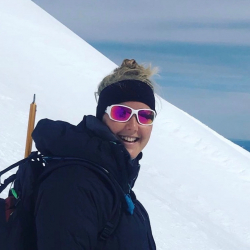Dr. Xianwei Wang is a remote sensing scientist, currently working in the Center for global Sea Level Change, New York University Abu Dhabi, UAE. He is interested in three-dimension changes of Thwaites Glacier and how Thwaites Glacier responsed to the surrounding warm ocean. He went to ice camp on Thwaites Glacier Front in February 2020 with KOPRI to install GPS and ApRES to detect the glacier motion and how rapidly the warm ocean can melt the ice base. His research for MELT combines satellite observations and ground measurements to better understand the glacier-ocean interactions in this region.
Clare Eayrs is a Research Scientist at the Center for global Sea Level Change, New York University Abu Dhabi. Her research focuses on the interaction between ice, the ocean, and the atmosphere. She is interested in understanding how changes in the cryosphere affect the global climate, with a particular focus on sea-level change.
Andrew is a PhD candidate in the School of Earth and Environment at the University of Leeds, and is investigating applying machine learning techniques to the analysis of passive seismic data.
Emma "Mickey" MacKie geophysical glaciologist and geostatistician studying subglacial conditions. As part of TIME, I will deploy a bistatic radar system to investigate englacial thermal conditions at the Thwaites Eastern Shear Margin.
TJ's research focuses on using a variety of field-based geophysical techniques to investigate the dynamics of ice sheets. In TIME, TJ develops and applies novel polarimetric methods to a variety of deployed radar systems to characterise the englacial ice anisotropic fabric and subglacial properties at the Thwaites Eastern Shear Margin. From these investigations, TJ will shed light on the physical properties of shear margins that enable streaming flow.
Paul Summers is a PhD candidate in Geophysics at Stanford University using numerical modeling to understand the mechanics of ice dynamics. He is particularly interested in investigating the controls on shear margin location and non-local dynamics of streaming ice.
Emma Smith is geophysicist and glaciologist, investigating ice dynamics using active and passive seismic techniques. As part of the ITGC TIME team she will focus on the acquisition and processing of 3-D reflection seismic data over the eastern shear margin of Thwaites Glacier, in order to determine the stability and properties of this key glaciological boundary.
Lucia Gonzalez is a PhD student in Geological Sciences at the University of Texas at El Paso, mainly interested in understanding glaciers and their dynamics, in addition to near-surface geophysics, by using active-source seismic techniques. In TIME, she will process and work with active-source and passive-source seismic data from the Thwaites Eastern Shear Margin.
Eliza Dawson is a PhD candidate in Geophysics at Stanford University using a combination of radar sounding data analysis and ice sheet modeling to investigate ice dynamics. Eliza was a member of the 2019-20 field team and deployed radar systems and conducted radar surveys across the Thwaites Eastern Shear Margin.
Jake Walter is a seismologist interested in earthquake physics and novel earthquake identification methodologies. He participates in the active and passive seismic portions of the TIME project and he led the 2019/20 TIME field season.
















